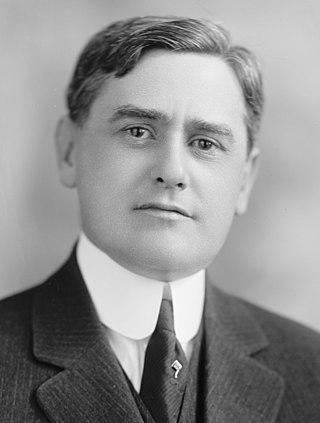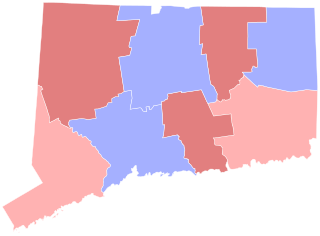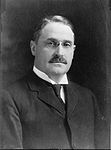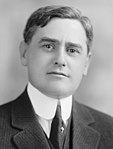
Since Connecticut became a U.S. state in 1788, it has sent congressional delegations to the United States Senate and United States House of Representatives, beginning with the 1st United States Congress in 1789. Each state elects two senators to serve for six years in general elections, with their re-election staggered. Prior to the ratification of the Seventeenth Amendment in 1913, senators were elected by the Connecticut General Assembly. Each state elects varying numbers of members of the House, depending on population, to two-year terms. Connecticut has sent five members to the House in each congressional delegation since the 2000 United States Census.

The 1958 United States Senate elections were elections for the United States Senate which occurred in the middle of President Dwight D. Eisenhower's second term. Thirty-two seats of Class 1 were contested in regular elections, the new state of Alaska held its first Senate elections for its Class 2 and 3 seats, and two special elections were held to fill vacancies.

The 1922 United States Senate elections were elections that occurred in the middle of Republican President Warren G. Harding's term. The 32 seats of Class 1 were contested in regular elections, and special elections were held to fill vacancies. With the Republicans divided between conservative and progressive factions, the Democrats gained six net seats from the Republicans while the Farmer–Labor party gained one. The Republicans retained their Senate majority.

Augustine John Lonergan was a U.S. Senator and Representative from Connecticut. He was a member of the Democratic Party. He served as a senator from 1933 to 1939.

Frank Bosworth Brandegee was a United States representative and senator from Connecticut.

The 2012 United States Senate election in Connecticut was held on November 6, 2012, in conjunction with the 2012 U.S. presidential election, other elections to the United States Senate in other states, as well as elections to the United States House of Representatives, and various state and local elections. Primaries to elect Senate candidates from the Republican and Democratic parties were held on Tuesday, August 14, 2012.

The 1932 United States Senate election in Connecticut was held on November 8, 1932. Incumbent Senator Hiram Bingham III ran for a second full term in office but was defeated by Democratic U.S. Representative Augustine Lonergan. This was the first time since 1879 that Democrats won this Senate seat, and the first since 1881 that they won either seat.

The 1920 United States elections was held on November 2. In the aftermath of World War I, the Republican Party re-established the dominant position it lost in the 1910 and 1912 elections. This was the first election after the ratification of the 19th Amendment, which granted women the constitutional right to vote.

The 1926 United States Senate election in Illinois took place on November 2, 1926.

The 1920 United States Senate election in Illinois took place on November 2, 1920.

From March 9 to June 5, 1920, voters of the Democratic Party elected delegates to the 1920 Democratic National Convention, for the purposing of choosing a nominee for president in the 1920 United States presidential election.

The 1938 United States Senate election in Connecticut was held on November 8, 1938.

The 1916 United States Senate election in Connecticut was held on November 7, 1916. Incumbent Republican Senator George P. McLean was re-elected to a second term in office over Democratic State Attorney Homer Stille Cummings.

The 1914 United States Senate election in Connecticut was held on November 3, 1914.

The 1914 United States Senate election in Colorado took place on November 3, 1914. It was the first direct U.S. Senate election in Colorado following the ratification of the Seventeenth Amendment. Incumbent U.S. Senator Charles S. Thomas, a Democrat, who was first elected by the state legislature to fill a vacancy in 1913, ran for re-election to a full term.

The 1922 United States Senate election in Minnesota took place on November 7, 1922. Farmer–Labor challenger Henrik Shipstead defeated incumbent Republican U.S. Senator Frank B. Kellogg and Democratic challenger Anna Dickie Olesen.

The 1926 United States Senate election in Connecticut was held on November 2, 1926.

The 1928 United States Senate election in Connecticut was held on November 6, 1928. Incumbent Republican Senator George P. McLean was not a candidate for re-election. In his place, Republican State Senator Frederic C. Walcott won the seat against former U.S. Representative Augustine Lonergan.

The 1930 United States Senate election in Minnesota was held on Tuesday November 4, Incumbent Senator Thomas D. Schal defeated Einar Hoidale of the Minnesota Democratic Party and Forner United States Representative Ernest Lundeen of the Farmer–Labor Party of Minnesota to win a second term.

The 2018 Connecticut Senate election was held on November 6, 2018, concurrently with the elections for the Connecticut House of Representatives, to elect members to the Connecticut General Assembly. All 36 seats in the Connecticut Senate were up for election. The election resulted in Democrats expanding control in both chambers of the Connecticut General Assembly, ending the split control in the Senate, that had been in place since the 2016 elections. Primary elections were held on August 14, 2018.
























